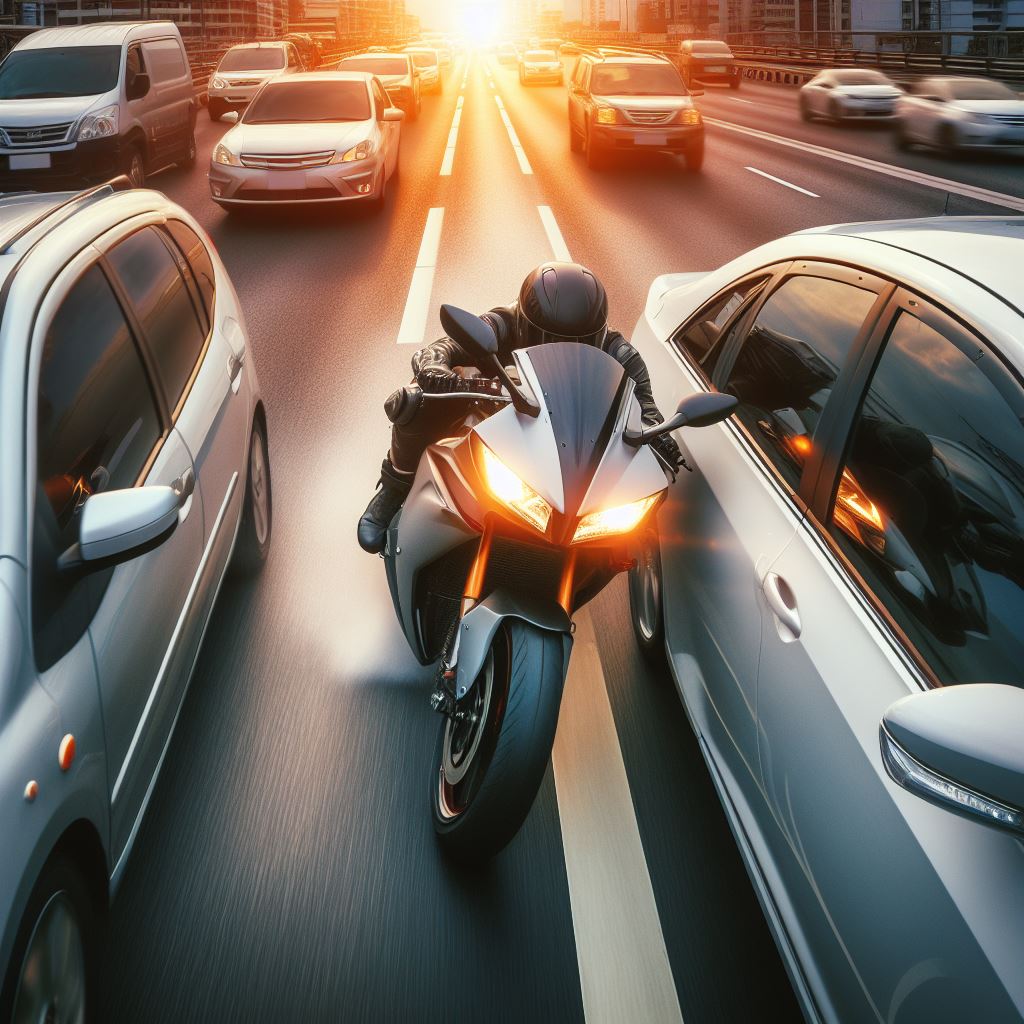Scenario One
You are driving in heavy commuter traffic in your vehicle. Some of the time you are moving at near the speed limit, but the traffic is backing up. At other points during your commute, the traffic is bumper to bumper, hits gridlock conditions, and you come to a full stop. Other motorists are jostling for position, trying to gain some advantage. You’re already at a high stress level. Just then, a motorcycle pulls between you and the cars in the lane next to you, and squeezes through. Or weaves around you between lanes while stopped at an intersection. You find yourself angry and outraged that motorcyclists get to “cheat” and break the law, while you are forced to wait because of traffic conditions.
Scenario Two
You are driving in heavy commuter traffic on your motorcycle. Traffic is slowing considerably, and is becoming gridlocked. While other vehicles are stuck waiting for the next traffic signal to change, or for vehicles in front of them to begin moving, you navigate your way between vehicles, around stopped cars, and move between lanes, without coming to a full stop yourself. A few cars honk their horns at you, and the odd driver or two has some unkind words for you as you pass them by. Why are other drivers always so angry?

What You Should Know About the Law
Lane splitting and lane filtering, the practice of motorcycles riding between lanes of slow-moving or stopped traffic, is a legal maneuver in a few select states. However, it is also a controversial practice that often upsets motorists. In this article, Cheapinsurance.com will explore the issue of lane splitting from all sides, answering key questions such as:
- What is motorcycle lane splitting?
- Is motorcycle lane splitting legal?
- Is motorcycle lane splitting safe?
- How does motorcycle lane splitting affect other motorists?
- What can be done to make lane splitting safer for everyone?
By the end of this article, you will have a better understanding of the issues surrounding lane splitting.
Key Takeaways:
- Motorcycle lane splitting or filtering, the practice of riding between lanes of slow-moving or stopped traffic, is legal in some states, but not all.
- The safety of lane splitting is a matter of debate, with some studies suggesting it can reduce the risk of accidents for motorcyclists and others suggesting it can increase it.
- Lane splitting can upset some motorists, who may feel it is unfair or dangerous.
- There are a number of things that can be done to make lane splitting safer for everyone, such as educating motorists about lane splitting, requiring motorcyclists to take lane splitting training, enforcing lane splitting laws, and designing roads that are more motorcycle-friendly

What is Motorcycle Lane Splitting?
Lane splitting, frequently incorrectly referred to as lane sharing or lane filtering, is the practice of motorcycles riding between lanes of slow-moving or stopped traffic. This can be done on either side of a vehicle, but it is more common for motorcycles to split lanes on the left side.
What is Motorcycle Lane Filtering?
Lane filtering, sometimes referred to incorrectly as lane splitting, is a legal maneuver in many states that allows motorcyclists to travel between lanes of slow-moving or stopped vehicles. Lane filtering is typically done when traffic is congested and vehicles are not moving at more than 15-20 mph.
What is Lane Sharing?
Lane sharing is when two motorcycles share the same lane, either side by side, or in a staggered configuration.
What is the difference between lane splitting and lane filtering?
Lane splitting and lane filtering are often used interchangeably, but there is a subtle difference between the two.
- Lane splitting refers to the practice of riding a motorcycle between lanes of moving vehicles.
- Lane filtering, on the other hand, refers to the practice of riding a motorcycle between lanes of stopped or slow-moving vehicles.
Where Is Motorcycle Lane Splitting Legal?
California
California is the only state where lane splitting is legal.
Experts in this state do recommend that motorcyclists only go ten miles per hour above the speed of the surrounding traffic and that they avoid lane splitting over speeds of 30 miles per hour. You also can’t lane split near freeway exits or ramps.
Where Is Motorcycle Lane Filtering Legal?
Arizona
Lane filtering is legal in Arizona as of 2022, but only under certain conditions.
- You can only ride between lanes of traffic stopped at a light.
- The speed limit of the road has to be less than 45 miles per hour.
- You can’t ride faster than 15 miles per hour.
- The street has to have at least two lanes of traffic traveling in the same direction.
- You have to be passing a car stopped in the same lane.
- You have to ride in the middle of the lanes, not on the median or shoulder.
These regulations are meant to keep motorcyclists safe during stop-and-go traffic situations.
Montana
In 2021, Montana joined the growing number of states that recognize the safety and efficiency benefits of lane filtering by legalizing the practice under certain conditions. Lane filtering allows motorcyclists to safely navigate between lanes of slow-moving or stopped vehicles to reduce congestion and travel time.
To ensure the safety of both motorcyclists and other motorists, Montana’s lane filtering law outlines specific conditions that must be met for the practice to be legal. These conditions include:
Speed Limit: The speed limit on the road must be 20 miles per hour or less.
Speed Differential: Motorcyclists must maintain a speed within 10 miles per hour of the surrounding vehicles.
Lane Width: The lanes must be wide enough to accommodate a motorcycle safely passing between vehicles.
Traffic and Road Conditions: Traffic and road conditions must be safe and allow for lane filtering without compromising safety.
Utah
Utah became the second state to legalize lane filtering in 2019, recognizing its potential to improve traffic flow and reduce congestion for motorcyclists. Similar to Montana, Utah’s lane filtering law establishes specific conditions to ensure the practice is conducted safely:
Speed Limit and Lane Requirements: The road must have at least two lanes of traffic traveling in the same direction, and the speed limit must be 45 miles per hour or less.
Speed Differential: Motorcyclists must limit their speed to 15 miles per hour while lane filtering.
Traffic Conditions: Lane filtering is only permitted when traffic is stopped or moving at a slow pace.
Lane Positioning: Motorcyclists must stay within marked lanes, avoiding shoulders and bike lanes.
Hawaii
While Hawaii doesn’t explicitly legalize lane splitting or filtering, it recognizes the need for alternative options for motorcyclists to navigate congested traffic. As a result, Hawaii allows “shoulder surfing,” a practice where motorcyclists ride on the shoulder of the road to pass stopped vehicles.
To ensure safety when shoulder surfing, Hawaii’s traffic laws mandate specific conditions:
Road Requirements: The road must have two lanes of traffic traveling in the same direction.
Traffic Conditions: Shoulder surfing is only permitted when traffic is stopped or moving at a slow pace.
Shoulder Positioning: Motorcyclists must remain on the designated shoulder, avoiding the roadway and bike lanes.
By establishing these guidelines, Hawaii aims to provide motorcyclists with a safe alternative to lane splitting while maintaining safety for all road users.
States Where Lane Splitting/Filtering is Not Legal Under the Vehicle Code
These states have specific laws that prohibit lane splitting and lane filtering.
- Alabama
- Alaska
- Colorado
- Connecticut
- Florida
- Georgia
- Illinois
- Indiana
- Iowa
- Kansas
- Louisiana
- Maine
- Maryland
- Massachusetts
- Michigan
- Minnesota
- Nebraska
- Nevada
- New Hampshire
- New Mexico
- New York
- North Dakota
- Oklahoma
- Oregon
* Lane Splitting was previously legal in Oregon, but was later revoked due to concerns and safety considerations - Pennsylvania
- Rhode Island
- South Carolina
- South Dakota
- Tennessee
- Vermont
- Virginia
- Washington
- Wisconsin
- Wyoming
States Where Lane Splitting/Filtering Have No Laws on the Books
In some of these states, lane splitting is considered legal, but it is up to the discretion of Law Enforcement to make the determination that a motorcyclist is operating in a safe and legal manner – if not, the motorcyclist risks being cited for a moving violation.
- Arkansas
- Delaware
- Washington, D.C.
- Idaho
- Kentucky
- Mississippi
- Missouri
- New Jersey
- North Carolina
- Ohio
- Texas
- West Virginia

Impact of Lane Splitting and Filtering Violations on Motorcycle Insurance
We’ve seen that lane splitting and filtering are legal maneuvers in many states that allow motorcyclists to travel between lanes of slow-moving or stopped vehicles. However, these maneuvers can also be risky, and violations of lane splitting and filtering laws can have a significant impact on a rider’s motorcycle insurance rate.
If you are concerned about the possible impact of lane splitting or lane filtering violations, there are a few things you can do to maintain an affordable motorcycle insurance policy.
- Follow the laws: Make sure you are familiar with the lane splitting and filtering laws in your state. Only lane split or filter when it is legal and safe to do so.
- Ride safely: When lane splitting or filtering, always ride slowly and carefully. Be aware of your surroundings and watch for other vehicles.
- Have a clean driving record: A clean driving record will show your insurance company that you are a safe rider. This can help you keep your premiums low.

Conclusion
Lane splitting is a complex issue with no easy answers. It is important to weigh the potential benefits and risks of lane splitting before forming an opinion on this practice. By understanding the law, the safety concerns, and the impact on other motorists, we can make more informed decisions about how to make roads safer for everyone.
Reference Resources:
- Motorcycle Safety Foundation: https://msf-usa.org/
- American Motorcyclist Association: https://americanmotorcyclist.com/
- National Highway Traffic Safety Administration: https://www.nhtsa.gov/
Take a look at more of our Motorcycle Insurance Articles!


